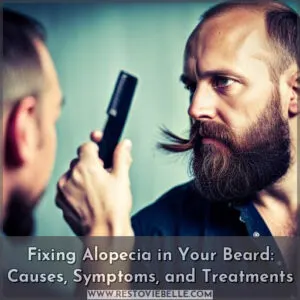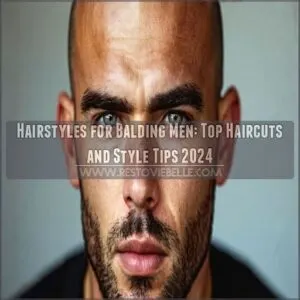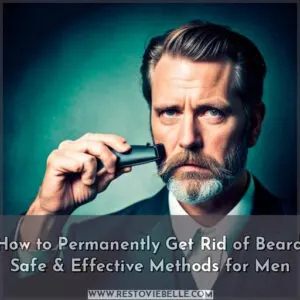This site is supported by our readers. We may earn a commission, at no cost to you, if you purchase through links.
 So, you’ve got a patchy beard, and you’re ready to tackle those bald spots like a pro.
So, you’ve got a patchy beard, and you’re ready to tackle those bald spots like a pro.
First things first: evaluate your diet, stress, and sleep habits—they’re the three musketeers of beard health.
Consider using minoxidil to stimulate growth or consult a doc about prp therapy or laser treatments.
If it’s a hormonal or autoimmune issue, a healthcare professional will be your best ally.
Don’t overlook some good ol’ hair fibers for a quick fix.
And speaking of nuts, check out how they factor into a beard-boosting diet.
Table Of Contents
- Key Takeaways
- Types of Beard Bald Spots
- Causes of Patchy Beards
- Diagnosing Beard Bald Spots
- Hormonal Treatments for Beard Bald Spots
- Treating Alopecia Barbae
- Quick Fixes and Home Remedies
- Beard Transplants for Bald Spots
- Maintaining a Healthy Beard
- Frequently Asked Questions (FAQs)
- Is there a way to fix bald spots in beard?
- Can you regrow patchy beard?
- Will a patchy beard eventually fill in?
- How do I get rid of spots on my beard?
- How does stress impact beard hair growth?
- Can fungal infections cause beard bald spots?
- What role does diet play in beard health?
- Are vitamin supplements effective for beard growth?
- How do genetic factors influence beard baldness?
- Conclusion
Key Takeaways
- Focus on your lifestyle’s three musketeers: diet, sleep, and stress. These guys are like the foundation of a robust beard brigade. Load up on healthy foods like nuts and greens, get enough beauty sleep, and find a way to manage stress before it rains on your beard parade.
- If those bald spots are playing hard to get, consider enlisting some help with minoxidil or check in with a doctor about PRP therapy or laser treatments. Think of them as your beard’s personal trainers, ready to whip those follicles into shape.
- Got odd-shaped patches or pesky rashes? It might be an infection sneaking in, like ringworm. A good hygiene routine can be your fortress, and antifungal treatments can help kick those unwelcome guests to the curb.
- Don’t forget your beard’s style points with quick fixes like hair fibers or micropigmentation for an instant confidence boost. It’s like giving your beard a snazzy new outfit—without the shopping spree!
Types of Beard Bald Spots
When you notice your beard isn’t as full as you’d like, different types of bald spots can be the sneaky culprits.
From the annoying alopecia barbae and hormone-related gaps to ringworm invasions and hair loss from medications or skipped Z’s, let’s face it, your beard might just be throwing a party you didn’t plan for!
Alopecia Barbae
Alopecia barbae is the sneaky culprit behind those unexpected beard bald spots.
It’s an autoimmune condition, with stubborn bald patches appearing like they’ve RSVP’d to their own party on your face.
While spontaneous remission is common, many look to alopecia barbae support groups or corticosteroids for advice and relief.
Don’t let those spots define you—explore your options!
Hormonal Imbalance
If your beard is looking patchy, it could be due to a hormonal imbalance.
Low testosterone or high levels of DHT can make your follicles less sensitive, leading to sparse growth.
Get your hormone levels checked and explore treatment options like minoxidil or platelet-rich plasma therapy.
With the right approach, you can regain a full, healthy beard.
Ringworm (Tinea Barbae)
Got a pesky bald spot in your beard? It might be a fungal infection called tinea barbae—ringworm’s mischievous cousin. This contagious fiend causes itchy, scaly patches.
Tackle it with antifungal creams and improve beard hygiene. Beard care’s a must! Picture your beard as a garden: keep it clean, and it’ll flourish.
Taking action quickly helps promote lively beard growth and fewer bald spots.
Medication-Induced Hair Loss
Medications can sometimes be a wolf in sheep’s clothing, sneaking in unwanted side effects like hair loss. Common culprits include specific hair loss drugs and chemotherapy-induced alopecia.
Don’t panic! With patience and a few lifestyle changes, your beard hair might make a comeback. Reassess your meds, chat with your doctor, and focus on kickstarting your hair growth recovery.
Sleep Deprivation
Sleep is the unsung hero of beard growth.
Imagine hair follicles as stressed workers needing rest to produce a luscious beard.
When insomnia strikes, it’s like pulling an all-nighter—hair loss becomes inevitable.
To prevent beard hair loss, prioritize bedtime!
Embrace sleep as a key beard hair loss remedy, and soon, your facial hair will thank you with newfound lushness.
Causes of Patchy Beards
Dealing with a patchy beard can be frustrating, but understanding the underlying causes is the first step to finding a solution.
From hormonal imbalances to medical conditions, there are several factors that can contribute to those pesky bald spots in your facial hair.
Hormonal Influence on Beard Growth
If your beard is looking patchy, hormones might be the culprit, affecting your ability to grow a full beard. Testosterone levels and DHT impact hair follicles, while hormonal imbalances or thyroid issues can also hinder beard growth.
Feeling stressed about beard hair loss? Consider trying products or seeing a beard hair loss specialist to address these challenges and regain your confidence.
Autoimmune Conditions
Autoimmune conditions, like alopecia areata, can make your beard pull a Houdini with sudden hair disappearance. The immune system mistakenly attacks beard follicles, causing patchy beard hair loss. You might wonder, "How’s this happening?"
Here are four common triggers:
- Stress
- Illness
- Genetics
- Environmental factors
Consider exploring hair loss treatments or consulting a professional for a proper autoimmune diagnosis for hair loss.
Medical Conditions and Medications
Medical conditions or medications could be pulling the rug out from under your beard! Some medications list hair loss as a side effect, so check that tiny print. Hormonal imbalances or autoimmune disorders are usual suspects too.
If your beard’s in a pickle, consult a specialist. Clinics offer treatments like hair transplants, but be aware of potential costs and side effects.
Poor Diet and Lifestyle Choices
Your diet and lifestyle choices can really impact your beard health.
Stress, poor sleep, and a lack of proper nutrition can all contribute to patchy, thinning facial hair.
Fuel your body with a balanced diet, stay hydrated, and prioritize quality sleep – these simple steps can promote thicker, healthier beard growth.
Ditch the junk food and embrace a beard-boosting lifestyle for the full, lush look you desire.
Diagnosing Beard Bald Spots
Don’t panic if you’re finding gaps in your beard – figuring out the cause might be easier than you think!
By checking for sudden changes, patch shapes, rashes, or any recent medication, you can play detective and pinpoint the issue.
Sudden Vs Chronic Hair Loss
Understanding sudden versus chronic beard hair loss starts with knowing the story your beard is trying to tell.
Has it been patchy since you were rocking braces, or did it just show up uninvited?
- Sudden loss could involve stress or medications.
- Chronic bald spots might point to genetics or age.
- Evaluate lifestyle choices like diet.
- Maybe it’s time for that trusty beard brush and balm.
Patch Shape and Size
Just like recognizing a familiar face in a crowd, identifying patch shapes in your beard helps pinpoint issues. Round patches often hint at alopecia barbae, while irregular patches or diffuse thinning may suggest other causes.
Don’t just brush off this clue—grab your trusty beard comb and inspect those spots.
Adjusting beard styles and using quality beard oil can help mask them.
Facial Rash and Inflammation
If you notice a pesky rash on your beard, it could be a sign of a fungal infection like ringworm.
Look for a circular, red, itchy patch – this may require a topical antifungal treatment.
Steer clear of irritants like harsh beard washes and razors, and opt for gentle, natural products to soothe the inflammation.
Medical History and Medication Review
Your medical history is like the blueprint of your beard journey.
Review it to spot medication side effects or interactions that might trigger beard hair loss.
Have any pre-existing conditions sneaked in?
Discuss treatment history and potential beard hair loss treatment with your doctor.
Hormonal Treatments for Beard Bald Spots
If you’re battling beard bald spots, hormonal treatments like minoxidil can awaken those stubborn follicles, giving your beard a boosting chance at regrowth.
Some people even turn to platelet-rich plasma therapy or low laser light treatment, proving that there’s more than one way to outgrow those patchy predators.
Minoxidil for Hormonal Patchiness
A little can go a long way with Minoxidil for hormonal patchiness.
It’s a popular go-to for boosting beard hair growth.
Slap it on your bald spots and watch your whiskers do the tango!
Check reviews for tips on application and be aware of its side effects.
Not seeing results? Consider looking into alternatives for better beard hair loss treatment success.
Platelet-Rich Plasma Therapy
Platelet-rich plasma (PRP) therapy can be a game-changer for patchy beards.
This innovative treatment harnesses your body’s own growth factors to stimulate dormant follicles and promote thicker, fuller facial hair, which can be helpful for addressing patchy beard issues.
The procedure is relatively quick, with minimal discomfort, and many men report seeing noticeable improvements in just a few months.
Give your beard the boost it needs with PRP!
Low Laser Light Treatment
Low Laser Light Treatment (LLLT) is a snazzy option for beard bald spots. Picture a mini lightsaber fight on your face. Here’s the lowdown:
- LLLT effectiveness varies, but reviews are promising.
- LLLT cost can burn a hole, but it’s worth a shot.
- Lightweight LLLT devices are easy to use.
- LLLT risks? Minimal—just some light readjustment!
Treating Alopecia Barbae
If you’re struggling with bald spots in your beard due to alopecia barbae, there’s no need to feel like a patchy pirate forever!
With treatments like corticosteroids and minoxidil, or even a trusty bottle of Vitamin E, you’ve got options to help your beard grow back and reclaim your dashing facial hair, especially if you’re dealing with conditions that affect beard growth.
Corticosteroids for Alopecia Barbae
Corticosteroids, whether applied topically or injected, are like your beard’s secret weapon against alopecia barbae. They can suppress inflammation and help regrow that patchy beard.
Be mindful of potential side effects like thinning skin.
Typically, treatment lasts a few months, with varying success rates. If it doesn’t work, exploring alternative therapies is wise. Don’t lose hope—your beard can bounce back!
Minoxidil for Alopecia Barbae
Minoxidil can be a game-changer for tackling alopecia barbae, the autoimmune condition that causes patchy beard hair loss.
While it may not work for everyone, many men have seen impressive results by applying this topical solution consistently.
Here’s what to expect:
- Increased blood flow to stimulate dormant follicles
- Thicker, fuller beard hair within 3-6 months of use
- Potential side effects like scalp irritation or unwanted facial hair growth
- Continued use required to maintain results
Vitamin E Supplements for Alopecia Areata
Ready to add some pep to your beard? Let’s talk Vitamin E! Known for its potential in alopecia areata treatments, it might just lend a hand. But, careful with the dosage; it’s a slippery slope. Studies on Vitamin E benefits hint at a boost, but always consult your doc. Remember, Rome wasn’t built in a day, so patience is key.
Supplement Potential Benefits Caution
Quick Fixes and Home Remedies
You’ve spotted a bald patch in your beard, but don’t worry, there are quick fixes and home remedies you can try.
From clever hair fibers to the magic of micropigmentation, let’s explore some easy ways to fill in those pesky gaps and boost your beard’s charm.
Hair Fibers and Thickening Sprays
For a quick beard fix, think of hair fibers and thickening sprays as a magic wand.
These products temporarily fill gaps, making your beard look fuller effortlessly.
Popular hair fiber brands offer easy spray application tips.
Consider cost comparison with natural alternatives for fixing bald spots in your beard effectively.
Beard Micropigmentation
For a quick fix to fill in those pesky beard bald spots, consider beard micropigmentation. This tattoo-like treatment can create the illusion of fuller, thicker facial hair – no matter your face shape or hair type. Just be mindful of the costs, longevity, and potential risks involved. With proper aftercare, you can achieve a natural-looking result that boosts your confidence.
- Customizable to your unique facial features
- Long-lasting (1-3 years) but not permanent
- Less invasive than a beard transplant
- Requires diligent aftercare to prevent infection
- May not be suitable for certain skin tones or medical conditions
Vitamin E Supplements for Beard Growth
If you’re considering beard micropigmentation, a quicker fix might be Vitamin E supplements.
They can enhance beard growth, addressing patchiness like a knight charges into battle.
Just remember, proper Vitamin E dosage is key to avoid side effects.
Try E oil application to boost beard thickness.
Though not magic, many find E for alopecia or patchy beards beneficial.
Healthy Diet and Lifestyle Choices
While Vitamin E has its perks, your beard journey also needs a healthy diet and lifestyle. It’s like baking a cake without frosting – not quite finished!
Boost beard growth by prioritizing: healthy hormone levels
- Stress management: Stay calm and carry on.
- Sleep hygiene: Rest well, dream big.
- Exercise impact: Move often, grow strong.
- Vitamin deficiency: Eat smart, stay sharp.
Beard Transplants for Bald Spots
If you’re tired of those pesky bald spots in your beard, beard transplants might just be your knight in shining armor.
Imagine this: a fuller, more confident you, thanks to a straightforward procedure that offers dramatic results—no magic beans required!
Effectiveness of Beard Transplants
Beard transplants can be a game-changer for those struggling with patchy facial hair.
With impressive long-term results, this procedure can transform your look by filling in those pesky bald spots.
Just imagine the confidence boost of rocking a full, lush beard – it’s a life-changing experience many have raved about.
The key is finding the right clinic and ensuring you’re a suitable candidate.
Eligibility and Suitability
Beard transplant candidates need to think about if it’s the perfect fit.
Not just anybody can jump on this train!
Think of:
- Age Limits: Does age affect results?
- Medical History: Check it before you wreck it.
- Hair Donor Area: Enough supply for demand?
Consultation and Procedure
You’re considering a beard transplant and might wonder if it’s worth the Beard Transplant Cost. First, book a free consultation to discuss your goals and expectations. As you prepare, think of it like getting ready for a big game. Remember, it’s not rocket science—it’s all about crafting your dream beard! Post-procedure care should keep things stylish and smooth.
| Preparation | Procedure | Aftercare |
|---|---|---|
| List goals | Date set | Sans stress |
| Ask questions | Feel refreshed | Gently groom |
| Dream beard | Enjoy your look | Stay chic |
Before and After Photos
With beard transplant results, the proof’s in the pudding! Before and after photos act as crystal balls for your future beard. They reveal patchy beard improvement and bald spot coverage, setting realistic expectations.
Just imagine your morning mirror reveals fuller hair growth. No more wishing and hoping—these snapshots offer tangible evidence of your beard’s potential transformation.
Maintaining a Healthy Beard
Maintaining a healthy beard is key to preventing and fixing those pesky bald spots.
From managing stress and getting enough sleep to eating a balanced diet, there are plenty of simple steps you can take to keep your facial hair looking its best.
Preventing Beard Bald Spots
While beard transplants can work wonders, maintaining a patch-free beard is about staying ahead of the curve.
Tame those bald spots by managing stress, eating a balanced diet, and getting your beauty sleep.
Lifestyle choices matter too; it seems genetics can throw a spanner in the works, but staying positive and proactive goes a long way.
Promoting Beard Growth
You’ve nailed the basics—now it’s time to boost growth.
Enhance your beard with growth supplements and oils. These nourish hair, leaving it gasping for more greatness.
Incorporating a beard care routine is like giving your beard a pep talk. A balanced diet supports growth, and don’t fall for beard growth myths—consistency is key, not wizardry.
Managing Stress and Sleep Deprivation
Growing your beard requires patience and a bit of stress relief.
Consider stress management techniques, like yoga or mindfulness practices, to help keep your hair happy.
Sleep like a log with solid sleep hygiene tips—consistent bedtime can work wonders.
If counting sheep isn’t cutting it, check for sleep disorders.
Maintaining a Balanced Diet
What you eat plays a big part in keeping your beard healthy and full.
Make sure you’re getting enough protein, vitamins, and minerals to feed those facial hairs.
Load up on biotin-rich foods like eggs, nuts, and leafy greens.
Supplement with beard-boosting vitamins if needed.
Proper nutrition will keep your beard looking its best.
Frequently Asked Questions (FAQs)
Is there a way to fix bald spots in beard?
For instance, John’s patchy beard was transformed after a beard transplant, boosting his confidence and appearance.
You can explore treatments like minoxidil, PRP therapy, or a beard transplant to fill in those pesky bald spots.
Can you regrow patchy beard?
You absolutely can regrow a patchy beard!
Try using minoxidil, which boosts growth, or check out platelet-rich plasma therapy.
Grab some healthy sleep too.
Alopecia barbae might need special care, but spontaneous recovery happens often!
Will a patchy beard eventually fill in?
Dreaming of a full beard?
Patchy areas might fill out over time, especially in your 20s, since hormones and genetics play major roles.
Embrace your unique look, but consider treatments if those gaps throw you a curveball!
How do I get rid of spots on my beard?
Tackling beard bald spots is like figuring out the chicken-and-egg puzzle of facial hair. Minoxidil helps, while a well-rested, healthy lifestyle adds punch.
Consider temporary thickening sprays or even a beard transplant for a confident, full look.
How does stress impact beard hair growth?
Stress can wreak havoc on your beard growth.
When you’re stressed, your body produces excess cortisol, which can disrupt the hair growth cycle and lead to patchy, thinning facial hair.
Try managing stress through exercise, meditation, and a good night’s sleep to keep your beard lush and full.
Can fungal infections cause beard bald spots?
Fungal infections, like ringworm, can cause bald spots in your beard.
These pesky fungi might sneak in with a rash, but treating them with antifungal meds will usually help reclaim your facial masterpiece (Source).
What role does diet play in beard health?
Imagine food as the fuel for your beard’s engine.
Eating a balanced diet, especially rich in proteins, vitamins, and minerals, gives your beard a better shot at flourishing.
Though it’s not a guaranteed magic spell.
Are vitamin supplements effective for beard growth?
Vitamin supplements like biotin, vitamin D, and zinc can boost beard growth by activating hair follicles, which can help address the issue of bald spots in beards. These supplements can help optimize beard growth by providing essential nutrients for healthy hair follicles.
They’re like magic beans for your face, but remember, they’re more effective with a balanced diet and healthy lifestyle (Source).
How do genetic factors influence beard baldness?
Genetics play a big role in beard baldness – some guys just have more sensitive follicles that are prone to thinning.
But don’t worry, there are treatments that can help thicken up those patchy spots.
Conclusion
Think of your journey to eliminating bald spots in your beard as assembling a puzzle: each piece—diet, sleep, stress, and treatment—comes together to create the full picture.
You’ve learned that everything from hormonal imbalances to stress impact your beard’s health.
Don’t hesitate to experiment bravely and wisely.
Whether you reach for hair fibers or opt for medical treatments, every bit counts.














